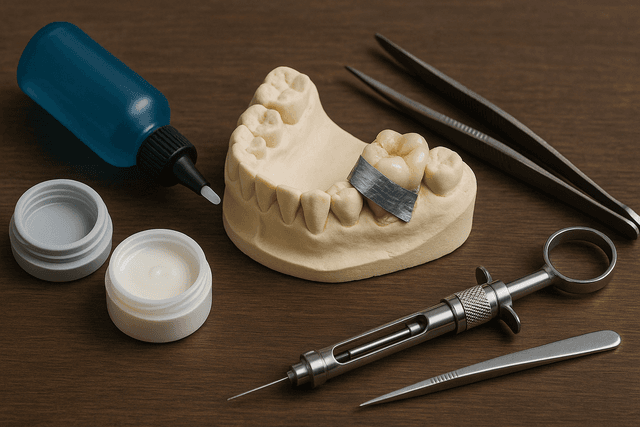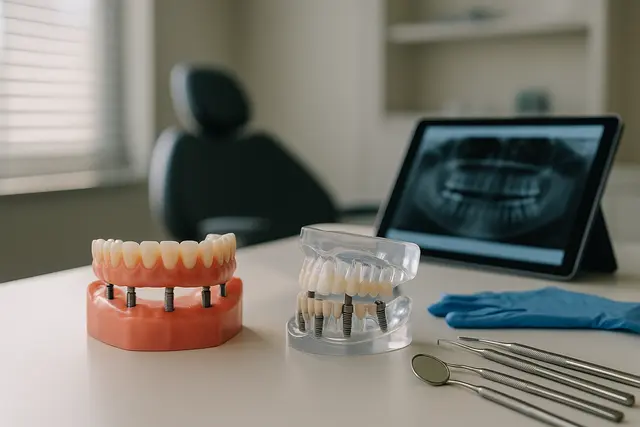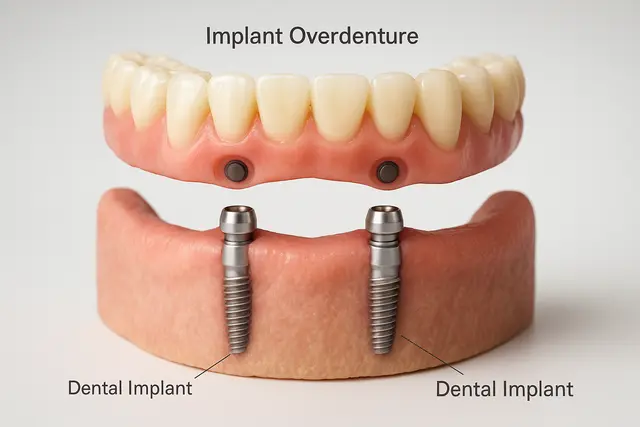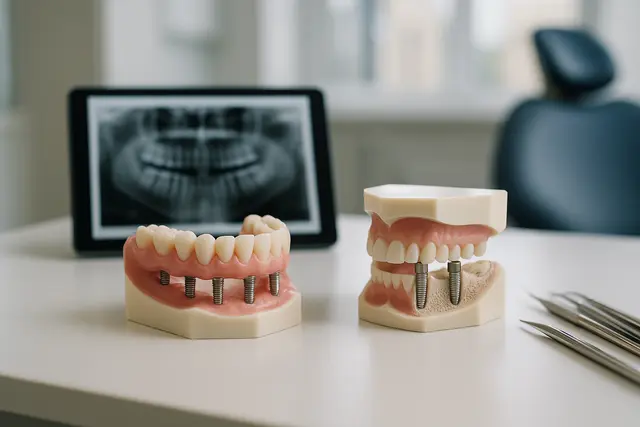Prosthodontics
6 min read
Jun 30, 2025
Your Guide to Emergency Crown Repair: Fast Fixes That Work
You never really think about your dental crown, until it suddenly cracks, comes loose, or pops right off mid-bite. One second you’re chewing normally, the next you’re holding a piece of your tooth like it betrayed you. If you're dealing with a dental emergency like a broken crown, don’t panic.

So, your dental crown just popped off, or worse, cracked in half. Maybe you were biting into something chewy, maybe it was just old. Either way, one minute everything was fine, and the next you're staring at a piece of your tooth in your palm, wondering what now. Welcome to one of the more common dental emergencies that always seem to happen at the worst possible time. But don’t panic. Let’s walk through how to handle emergency crown repair quickly, safely, and without adding more stress to your already aching mouth.
When a Dental Crown Turns Into an Emergency
A dental crown is meant to protect and restore your tooth when it’s been compromised, whether from decay, a root canal, or a cracked tooth structure. But like anything else in your mouth, a crown can wear down, come loose, or straight-up fall off. If your crown breaks or dislodges, you’re now dealing with an emergency dental situation. Not only is your underlying tooth exposed and vulnerable, but you might also experience pain, sensitivity, or even difficulty chewing.
Emergency dental crown cases aren’t rare, and they’re definitely considered a dental emergency, especially if you're dealing with pain or an exposed tooth. The sooner you seek professional dental help, the easier it’ll be to repair or replace the crown before it leads to more serious dental issues.
Tooth Trouble? Here's Why It Happens
Let’s talk tooth for a second. The crown may cover it, but the tooth underneath still matters a whole lot. A crown can become broken or loose due to everyday wear and tear, tooth decay sneaking in underneath the crown, or just bad luck, a popcorn kernel here, a toffee there. If the tooth structure supporting your crown starts to weaken, the crown may not fit as securely, which makes it easier to dislodge the crown completely.
A cracked or broken crown is also a sign that it might be time for a new dental crown. Some crowns, especially older porcelain ones, eventually chip or fracture. And if you’re grinding your teeth at night (hello, stress), even the best-made crown can break down over time.
See Your Dentist for Crown Repair ASAP
Look, no one schedules their week around a dental emergency, but if your crown falls off or breaks, you need to contact your dentist immediately. Waiting too long can expose the underlying tooth to bacteria, temperature sensitivity, or even further breakage. That exposed tooth is now vulnerable to more decay or damage, and let’s be real, your smile’s not going to be thrilled either.
An emergency dental appointment can examine your tooth, clean the area, and decide whether crown repair is possible or if you’ll need a replacement. In some cases, a simple re-cementing with professional dental cement will do the trick. In others, especially if the crown or tooth is severely damaged, your dentist may recommend a new crown to restore your smile and protect your tooth long-term.
Emergency Dental Crown Solutions at Home (For Now)
Can’t get to the dental office right away? Here’s how to apply a safe, temporary fix at home, because going without a crown for days isn’t ideal.
Clean the crown and tooth gently. Rinse both with warm water. Don’t scrub. You’re trying to avoid damaging the crown or irritating the exposed tooth.
Use over-the-counter dental cement or dental wax. These are your best bets for keeping things in place until your appointment. You can find temporary dental cement at most pharmacies. If the crown fits, clean it and gently press it back onto the tooth with the cement. If it doesn’t fit well, don’t force it, use dental wax to cover the exposed tooth instead.
Avoid sticky or hard foods. This isn’t the time for peanut brittle or steak night. You want to prevent further damage to the tooth or dislodging what’s left of the crown.
Over-the-counter toothache remedies can help if you're dealing with pain or discomfort.
Just remember, these are temporary fixes. Don’t assume you're in the clear until a dentist confirms it. The longer you delay professional dental care, the higher your chances of developing dental issues if left untreated.
Dental Crown Repair vs. Replacement: What’s the Plan?
Not every crown breaks the same way. Some just come loose. Others crack down the middle. The question becomes: do you repair or replace?
If the crown is intact and the underlying tooth is healthy, your dentist may be able to reattach it with dental cement during your dental appointment. That’s the best-case scenario, fast, affordable, and back to business.
But if the crown is chipped, the tooth is decayed, or the fit is no longer secure, you’ll probably need a new crown. Your dentist will take impressions, possibly add a dental filling to rebuild the damaged tooth, and place a temporary crown while your new dental crown is being made.
And yes, porcelain crowns are still a popular choice. They offer strength, match your natural tooth color, and can last many years with proper care.
What to Do If the Crown Falls Out Completely
When your crown falls out, the exposed tooth becomes vulnerable. You may feel sharp edges, pain, or sensitivity. Don’t panic, but don’t ignore it, either.
Start with a rinse, then cover the tooth with dental wax if needed. If you still have the crown and it looks whole, keep it safe and bring it with you to your emergency dental appointment. Your dentist will examine your tooth and determine if the existing crown fits or if you’ll need a new crown.
But whatever you do, don’t chew on that side, don’t leave it uncovered, and don’t go weeks without seeing a dentist. That exposed tooth is not a “wait and see” situation, it needs attention.
Protect the Tooth and Prevent Further Damage
Once you’ve had your crown fixed, you’ll want to protect your tooth from a repeat performance. That means brushing and flossing daily (without going full lumberjack on your gums), avoiding habits like nail-biting or ice chewing, and sticking to regular dental checkups.
If you grind your teeth, ask your dentist about a night guard. And remember, even the best crown can fail without good oral hygiene. Keeping the tooth and surrounding gums clean reduces the risk of decay, which is one of the biggest reasons crowns fail.
Good oral habits equal longer-lasting dental work. It's really that simple.
When the Crown and Tooth Don’t Agree
Sometimes, the damage goes deeper. If decay has taken root under the crown, or if the tooth structure is compromised, your dentist may need to perform additional work before placing a new crown. This might involve a dental filling, root canal, or even building up the tooth with bonding material.
A broken dental crown can be frustrating, but your dentist has plenty of tools to fix the situation and restore your tooth to its former glory. Don’t wait. The longer the crown is off, the more problems you may invite.
Emergency Dentistry: Know When It’s Time to Call
Still unsure if this counts as a true emergency? Here’s your quick checklist:
You’re in pain or experiencing tooth pain
The crown is completely off
The crown breaks and leaves jagged edges
You can’t chew without discomfort
You feel the crown is loose and might dislodge
If any of these are true, it’s time to call for emergency dentistry. Don’t try to tough it out, emergency dental care is there to protect your health and prevent further damage.
Final Thoughts
Nobody expects to deal with a dental emergency, and definitely not a broken crown. But knowing how to react, and getting care as soon as possible, can save your tooth, your time, and your wallet. Whether you’re applying a temporary fix or heading straight to the dentist, the goal is simple: protect your tooth, restore your smile, and keep your oral health on track.
Emergency crown repair isn’t just about fixing something broken. It’s about staying ahead of the damage, treating your mouth with the care it deserves, and trusting your dentist to help you get back to eating, laughing, and smiling without worry.
What Should I Do Immediately If My Dental Crown Falls Out?
Rinse your mouth and the crown gently with warm water. If the crown is intact, you can use over-the-counter dental cement to temporarily place it back. If it doesn’t fit properly, cover the exposed tooth with dental wax to prevent sensitivity and avoid chewing on that side until you see your dentist.
Is a Broken or Loose Crown Considered a Dental Emergency?
Yes, especially if the underlying tooth is exposed, causing pain or sensitivity. A dislodged crown leaves your tooth vulnerable to damage and decay. You should contact your dentist as soon as possible to prevent further complications and restore protection to the tooth.
Can a Dental Crown Be Repaired or Will I Need a New One?
If the crown is still intact and the tooth underneath is healthy, your dentist may be able to clean and re-cement it. However, if the crown is cracked, the tooth is decayed, or the fit is poor, you’ll likely need a new crown. Your dentist will evaluate and recommend the best option.
How Can I Prevent My Crown From Breaking Again?
Practice good oral hygiene, avoid chewing hard objects like ice or popcorn kernels, and wear a night guard if you grind your teeth. Regular dental checkups help catch issues early. Keeping the tooth and gums clean reduces the risk of decay under the crown, which is a common cause of failure.Ask ChatGPT
Read Next
Related Posts

Prosthodontics
Implant Supported Dentures Overview
Missing teeth can impact more than just your smile, they can affect your confidence, comfort, and even your diet. Fortunately, modern dentistry offers a solution that’s both secure and natural-looking: implant-supported dentures. This innovative approach blends the stability of implants with the convenience of dentures to create a long-lasting, life-improving upgrade.
5 min read
Oct 29, 2025

Prosthodontics
Implant Overdentures Explained: The Hybrid Solution to Missing Teeth
Missing teeth can impact everything from your ability to eat to your self-confidence. While traditional dentures have long been a go-to solution, they often fall short in comfort and stability. Implant overdentures offer a modern alternative that combines the security of dental implants with the convenience of removable dentures, a true upgrade for those looking to reclaim their smile.
6 min read
Oct 29, 2025

Prosthodontics
Implant Retained Dentures Explained
Considering implant-retained dentures? You're not alone. As modern dentistry evolves, more people are turning to this secure, natural-feeling alternative to traditional dentures. This guide will walk you through what they are, how they work, and why they might be the solution you've been looking for.
4 min read
Oct 28, 2025
Don’t have time to research every dentist around you?
See why 30k+ patients trusted us